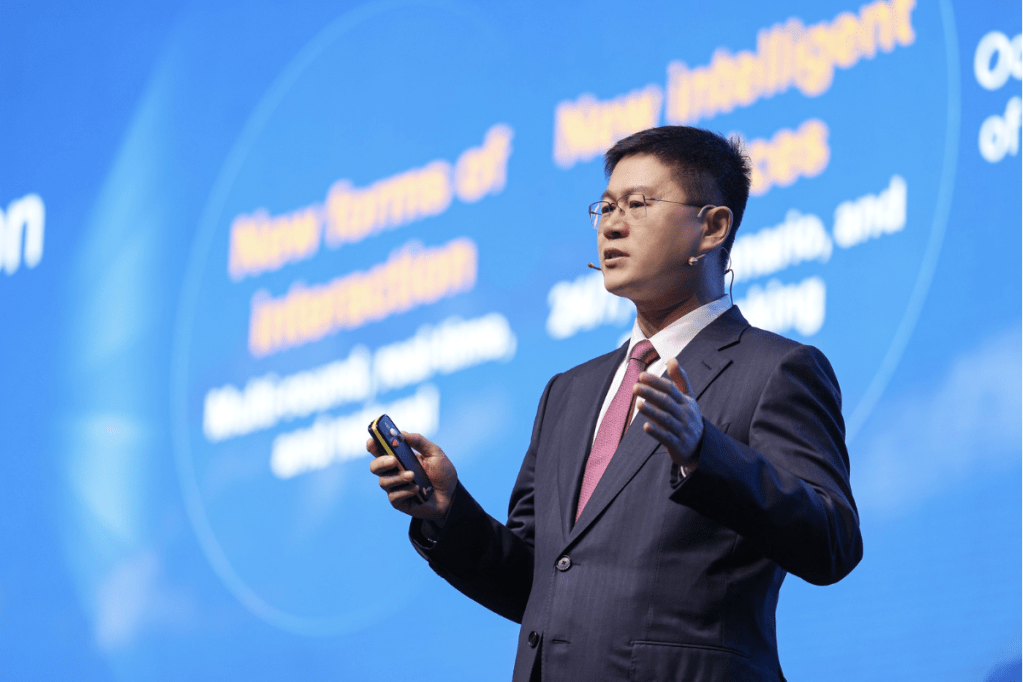The convergence of 5.5G commercialization and artificial intelligence has marked 2024 as a pivotal year for the mobile industry. This development took center stage at the Global Mobile Broadband Forum 2024 (MBBF 2024) in Istanbul, where industry leaders gathered to explore how 5.5G will shepherd the mobile AI era.
With more than 1,000 representatives from mobile carriers, ecosystem players, and vertical industries in attendance, the forum’s theme, “5.5G Leads Mobile AI Era,” couldn’t be more timely. The mobile industry stands at a crucial juncture where AI applications have outpaced traditional apps, with over 3 million AI-capable applications already developed globally.
During his keynote address, Li Peng, Huawei’s Senior Vice President and President of ICT Sales & Service, painted a vivid picture of how AI will reshape the mobile landscape. “The mobile AI era is here,” Li declared, emphasizing that intelligence will become as ubiquitous as voice calling and mobile internet have become today.
The transformation is already visible in the device ecosystem. IDC predicts that by 2028, annual AI smartphone shipments will exceed 900 million units, with more than 1,000 AI-native devices expected to enter the market. These devices will revolutionize human-machine interaction through advanced capabilities like emotion recognition and sophisticated gesture control, marking a significant departure from traditional touch-based interfaces.
Perhaps the most transformative aspect of this evolution is the emergence of AI agents. By 2030, personal AI assistants will become commonplace in homes, offices, and during travel, operating continuously and generating data volumes that dwarf current levels. In industrial settings, AI robots will become integral to operations, processing over 10 GB of data per hour and driving a 120-fold increase in total data processing compared to today’s standards.
“We will interact with these devices in many new ways, including voice, gestures, and even emotions. The experience will be smoother, and the devices will understand us better – so interactions will be much more efficient,” said Peng.
This explosive growth in AI-driven data consumption forces a fundamental rethinking of network architecture. Unlike traditional unidirectional traffic patterns, AI applications require multi-directional data flows, creating complex mesh networks connecting devices, edge computing resources, and cloud infrastructure. This shift demands networks capable of handling increased uplink bandwidth, providing deterministic latency and ensuring unprecedented reliability.
The implications for mobile operators are significant. Success in the mobile AI era requires reshaping four key areas: network services, infrastructure, operations and maintenance (O&M), and business models. Leading carriers are already adapting by launching AI-enhanced services like 5G New Calling, which has attracted over 24 million users in China alone. These services demonstrate how AI can transform basic communication features into rich, interactive experiences with real-time translation and digital avatar capabilities.
Infrastructure evolution is equally crucial. To support natural AI interactions, networks must deliver end-to-end latency under 300 milliseconds, with air interface latency below 20 milliseconds. This demands the development of AI-centric networks with deterministic access and elastic scheduling capabilities.
The new surge in data from AI will also drive structural changes in traffic models. In traditional traffic models, data flows in a single direction. Like video content from data centers to smartphones, the data is general, and the flow is linear.
AI will transform this flow. Data will be personalized and flow in multiple directions. For example, training large models requires super-fast transmission between data centers. At the same time, AI applications and AIGC must transmit data between edge, cloud, and devices. The result is a significant rise in east-west traffic and mesh connections between multiple types of devices and hosts.
With the structural changes in traffic models, network optimization will be more critical than ever. We need to provide larger uplink bandwidth, deterministic latency, and more reliable network capabilities to meet these new service requirements.
The increasing complexity of these networks presents both challenges and opportunities. AI itself offers a solution through automated O&M, with AI agents and copilots streamlining operations and maintenance tasks. This automation is essential for managing the sophisticated network environments required for AI services.
Perhaps most importantly, the mobile AI era opens new revenue streams for operators. Early adopters are already moving beyond traditional traffic-based pricing to experience-based monetization models. European carriers have successfully introduced speed-based mobile plans, while Chinese operators are exploring multi-factor monetization through AI-enabled services.
Ken Hu, Huawei’s Rotating Chairman, emphasized the universal nature of this transformation: “In the future, AI will change everything. Everyone will be able to use it, anytime and anywhere.” This vision aligns with the industry’s trajectory toward making AI as accessible as traditional mobile services.
The path forward requires a dual approach: preparing networks to support AI while leveraging AI to optimize network operations. This symbiotic relationship between AI and 5.5G networks will be crucial for unlocking the full potential of the mobile AI era.
“The opportunities are great. And the best time to act is now. Huawei is ready to work with carriers and industry partners to build networks for AI and AI for networks,” Peng added.
As we enter into this new era of transformation, the success of early deployments and the clear roadmap presented at MBBF 2024 suggest that the mobile AI era is not just a vision but an imminent reality. The convergence of 5.5G and AI represents more than a technological upgrade; it marks the beginning of a new chapter in mobile communications where intelligence becomes truly ubiquitous.

